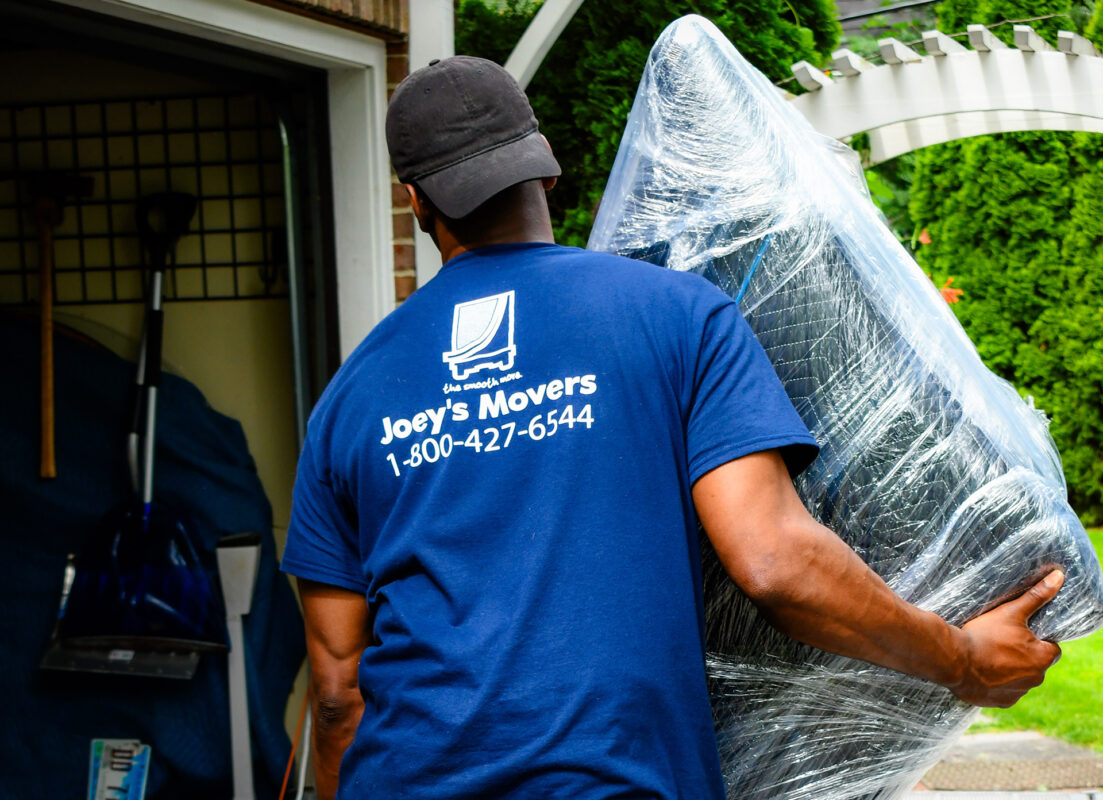Learning how to move furniture by yourself might seem overwhelming, but with the right tools and techniques, it’s completely doable. You need a solid plan, the right tools, and a clear understanding of how to protect yourself and your home. Professionals rely on simple but effective techniques that you can use as well. With a bit of planning, you can protect your floors and walls, avoid hurting your back, and keep your furniture in good shape.
In this guide, you will learn:
- How to prep your space
- How to choose the right equipment
- How experts move everything from sofas to dressers
We care about your health and safety, so at the end, we’ll also include signs that hiring pros will save you money and your health.
Know Your Limits When Handling Furniture on Your Own
There are limits to what we can do by ourselves during a move. Injuries like cuts, scrapes, strains, back injuries, and broken toes or fingers all happen due to overestimating our abilities and failing to prepare appropriately. This leads to damaged floors, broken glass, gouged entryways, and scratched walls.
Before you move anything, take time to evaluate the situation. Ask yourself things like
- How is your physical ability? Are there any injuries or medical conditions that you need to account for? Are there any injuries, allergies, or illnesses that could worsen with the physical strain related to the task?
- How demanding is the task? Extra large, fragile, or bulky furniture will require special handling, and some will require more than one person, even with tools to help you.
- How far do you need to move the furniture, and what obstacles are there? Do you need to handle doorways, stairs, or tight spaces? Is there a lot of clutter or furniture in between the furnishing and your destination?
- What do you risk damaging during the move? Will you need to protect the flooring? Are there corners you could ding or fine art pieces you might knock over? Walk yourself through the entire path you need to take and note what you need to protect along it.
The goal is to eliminate surprises and potential damages. It also helps you feel out areas you need an extra hand with. If you don’t want to move your furniture by yourself, considering hiring the pros at Joey’s Movers. Call us at xxx or get an online quote!
Essential Tools to Move Furniture by Yourself
Whether you’re moving across the room or into a new space, knowing how to move furniture by yourself without injury or damage starts with having the right equipment. Using the right tools makes all the difference when you’re moving furniture alone. These tools make the job easier and protect your body, your belongings, and your home.
Furniture sliders reduce friction and protect floors.
Furniture sliders can help reduce strain and give you more control over the movement of large and bulky furniture. To use furniture sliders, lift one corner of the furnishing at a time and slide the pads underneath. Once in place, you can push or pull the piece with far less effort.
Choose the correct type of sliders for your flooring. For carpeted areas, go with hard plastic sliders that glide smoothly without bunching. On hardwood, tile, or laminate, use felt or rubber-backed sliders to prevent dings and scratches.
Lifting straps distribute weight more evenly across your body.
Lifting straps loop around your shoulders or forearms to shift the load from your back to stronger muscle groups like your legs and shoulders. This helps you reduce strain and maintain better posture while moving furniture.
Lifting straps are ideal for large, awkward pieces like mattresses or solid nightstands. Ideally, you should work with at least one other person to distribute the weight evenly between you, but they are still useful as leverage when you move furniture by yourself.
Dollies provide stability and control when you move heavy furniture.
A dolly reduces effort and injuries by carrying the weight and allowing you to roll the furniture around instead of carrying it.
A two-wheel dolly (also called a hand truck) works best for stacked boxes or narrow items that you can tip upright. A four-wheel dolly is better for broader and heavier pieces like dressers, desks, or appliances. Set the item flat on the platform, center the weight, and secure it with moving straps or rope if needed.
Make sure the dolly has rubber wheels to avoid damage to your floors. Metal and plastic wheels can damage doorway thresholds and leave marks on vinyl or some hardwood floors.
Ram boards create protective barriers.
Ram Board is also a solid choice to protect your carpets. This material creates a thick spill-proof barrier between your furniture and the floor. You can cover the full surface, or you can use it to create protected moving paths. The surface makes it easier to slide dollies and furniture around, and if you drop anything, it will prevent impact damage to the floor.
Wrap furniture in moving blankets or pads to prevent damage.
Moving blankets and pads create a protective barrier between the furniture and your walls, floors, and doorframes.
When you use the right equipment, you stay in control. It speeds up the job, keeps you and your belongings safer, and reduces the physical strain related to the move.
How to Move Heavy Furniture on Carpet by Yourself
Carpet fibers increase friction, which causes a large number of challenges and issues when you are moving furniture by yourself. For example:
- You can stretch, tear, or permanently dent the carpet.
- If you push too hard, furniture legs can snag and rip the carpet or topple the furnishing over.
- Dragging furniture without protection can also cause unsightly stains or track marks.
Here are some ways to avoid issues when you move heavy furniture across carpeted areas.
Use furniture sliders designed for carpeted floors.
Don’t use felt sliders meant for hardwood; they’ll sink into the carpet and not move effectively. Pick broad plastic or Teflon sliders specifically made for carpet.
Lift each corner one at a time using your legs (not your back) and position the slider directly under the legs or contact points. Make sure the flat side of the slider faces down toward the carpet.
Use controlled, steady force to push the furniture.
Stand close to the furniture and push from a low, stable point. Push slowly to maintain balance and reduce the risk of tipping it over. If you feel it start to tip or catch into the carpet, stop immediately and adjust your position. If needed, pause on the task until you can get assistance or an appropriate tool.
Use your leg muscles, not your back.
Don’t rely on your arms or back to generate force. Use your legs to create forward momentum while keeping your spine straight. This approach gives you better control and reduces the strain on your back and shoulders. If you feel the furniture start to lean or if the carpet bunches up, stop and reposition.
Use extra care on high-pile or plush carpet.
Thicker carpets can make the surface uneven and unsteady, even with sliders. If you find yourself struggling, consider using larger sliders or making a path with a Ram board to improve movement and control.
How to Move Furniture Without Furniture Sliders
If you don’t have access to furniture sliders, you can still move heavy pieces using household items. Be very careful if you use this option! These materials are not designed for the task, so they are more prone to problems like breaking, catching, and slipping out of position. Only use these alternatives if the furniture is relatively easy to control and you are only moving a short distance with minimal obstacles.
Here are a few common DIY alternatives to furniture sliders:
- Folded towels provide some cushion and reduce direct contact with the floor. Use thick, tightly folded towels to create a flat base under each leg. This works best on flat, hard flooring.
- Thick, sturdy cardboard pieces work like a much more fragile form of Ram board. Make sure it is thick and sturdy enough to avoid bending under the weight of the furniture. If you need to use it as a furniture slider, curl the sides up slightly to reduce the chances of them catching on the floor as you move.
- Plastic container lids from storage bins can function similarly to plastic sliders. Choose rigid, flat lids that won’t crack under weight. Ideally, the edges and corners should be rounded to reduce catching and resistance.
- Soft, small rugs or carpet pieces can help the furniture glide more easily across tile or hardwood. Place them fabric side down to protect the surface and reduce friction. Don’t use rough fabrics as they can scratch the surfaces.
Make sure the improvised slider fits securely under the leg or base. If it curls or shifts as the furniture moves, stop using it immediately. When in doubt, wait until you have proper sliders to work with. It can save your flooring, your furniture, and your back.
How to Move a Dresser by Yourself With a Dolly
A dolly allows you to roll a dresser instead of lifting and carrying its full weight. It dramatically reduces physical strain and lowers the risk of dropping or damaging the item as you move it.
Here are the steps to move a dresser safely with a dolly:
- Empty the drawers or secure them in place.
- Tilt the dresser carefully to one side while using your legs, not your back.
- Slide the dolly under the dresser and center the weight.
- Secure the dresser with straps or rope.
- Push slowly and steadily, using your legs for strength and balance. Hold both sides of the dresser and move at a steady pace. Watch for uneven flooring, door thresholds, or any objects in your path. If you’re going down a step or curb, lower the dolly slowly while keeping the load steady.
Be extra cautious around stairs! If you must move the dresser up or down stairs, use a stair-climbing dolly or get someone to help you. This is a high-risk area to manage heavy furniture by yourself.
Tips for Lifting Heavy Furniture
Improper lifting is one of the top causes of moving injuries, even among professionals! According to the Bureau of Labor Statistics, over one million workers will hurt their back every year, and three out of four back injuries happen while lifting.
This means even the pros can not completely avoid back injuries, so don’t take improper lifting procedures lightly. We care about you making it through your DIY project without an issue. Here is the proper lifting procedure to reduce the risk of a back injury:
- Wear work gloves to protect your hands and improve your grip.
- When lifting something heavy, get close to the object, bend your knees, and tighten your stomach muscles. Let your legs support your body as you stand, and keep your back straight.
- Keep the object close to your body, and do not twist your body as you stand or turn. Instead, pivot with your feet.
- Don’t try to lift and carry an object all in one motion if you don’t have to. Pause as needed to reset your grip and reposition your hands. Focus on getting to your destination uninjured instead of fast.
- If the object is too heavy to lift and carry correctly, ask someone for help or use tools like a lifting strap or a dolly.
Remember that as you get tired, your form may suffer. Take breaks, hydrate, and don’t try to move every piece of furniture in one session. Safe lifting takes patience, but it pays off by preventing injuries that could delay your entire move and affect your daily life.
Navigating Doorways, Stairs, and Tight Spaces
One of the most overlooked parts of moving heavy furniture alone is the challenge of navigating through narrow doorways, tight hallways, and staircases. Poor planning can lead to scratched walls, damaged furniture, or personal injury. Here’s how to get large items through tricky spaces safely when moving by yourself.
- Measure everything before you move, including the doorways, stairwells, and hallways.
- If a doorway is just slightly too narrow, remove the door from its hinges. Most interior doors can be removed easily with a screwdriver or hinge pin remover. If this is still not enough, you may need to consider dismantling the furniture and carrying it out in smaller pieces.
- Make sure the route is free of tripping hazards like rugs, toys, or shoes. Remove any wall decor or light fixtures that could be bumped along the way.
- Tilt, hook, and pivot when needed. Large furniture doesn’t always pass through a doorway or narrow space straight on. For example, to get a sofa through a doorway, you can stand it on one end and “hook” it through the door frame. Pros also tilt and pivot objects instead of dragging them to reduce friction.
- If you are navigating stairways, disassemble furnishings as much as possible and use straps or hand trucks. For added safety, do this with at least one other person.
- Disassemble bulky or complex furniture. Disassembling reduces weight and makes items easier to fit through small spaces. Label all parts and store screws and small hardware in clearly marked bags.
- Use moving blankets to protect your surroundings. If you’re navigating tight corners, padding both the item and the wall corner gives you an extra layer of protection.
- Don’t rush through tight areas. Take your time in narrow spots and adjust your grip or footing before making each move. Always know your next step before you take it.
If you’re unsure whether a piece will fit, step back and reassess. If some pieces seem too complex to handle alone, consider calling in help for just those items. The cost of professional help is often less than the cost of injury or repairs.
When to Ask for Help or Hire a Pro
Not every piece of furniture should be moved alone. Recognizing when to hire a professional can protect your health, your furniture, and your home.
- If you’re struggling to lift a piece off the ground, feel unbalanced, or can’t see where you’re going, it’s time to stop. Forcing a move increases your risk of back injuries, dropped items, or damaged floors and doorways. Listen to your body. Fatigue, pain, or even hesitation are signs that a task may be beyond what’s safe to handle alone.
- When you are dealing with top-heavy, awkward, or fragile items, you should get help. Trying to manage these items solo puts you at high risk for serious injury or costly damage. Even with the best tools, these pieces often require at least one other person for safe movement.
- Leave fine art and large collectibles to the pros. Even a small chip or crack can plummet their value. It’s better to invest in a moving pro that specializes in moving fine art.
- Hire professionals for strategic support. Many movers, including Joey’s Movers, offer partial-service options. You can hire pros to help you declutter, move specialty items, or provide secure storage solutions.
Knowing when to pivot from a DIY approach to professional support doesn’t mean you’ve failed—it means you’re smart enough to avoid unnecessary risks.
Call Joey’s Movers at (847) 674-7779 or get a free quote online. We’ll help you handle the heaviest and most complex parts of your move safely and efficiently.
Final Recommendations
By learning how to move furniture by yourself, and using the right equipment and strategies, you can protect your body, your furniture, and your home—all without needing a full moving crew. Use furniture sliders, lifting straps, and dollies to reduce strain and protect your home. Move slowly through tight spaces and disassemble large items when needed.
Some furniture isn’t safe to move alone. Recognizing your limits isn’t a setback, it’s smart. When the job gets too risky, calling in professionals for a few key items or exhausting tasks can save you time, injury, and repair costs.
Need a hand? Call Joey’s Movers at (847) 674-7779 or get a free online quote for fast, reliable help.



